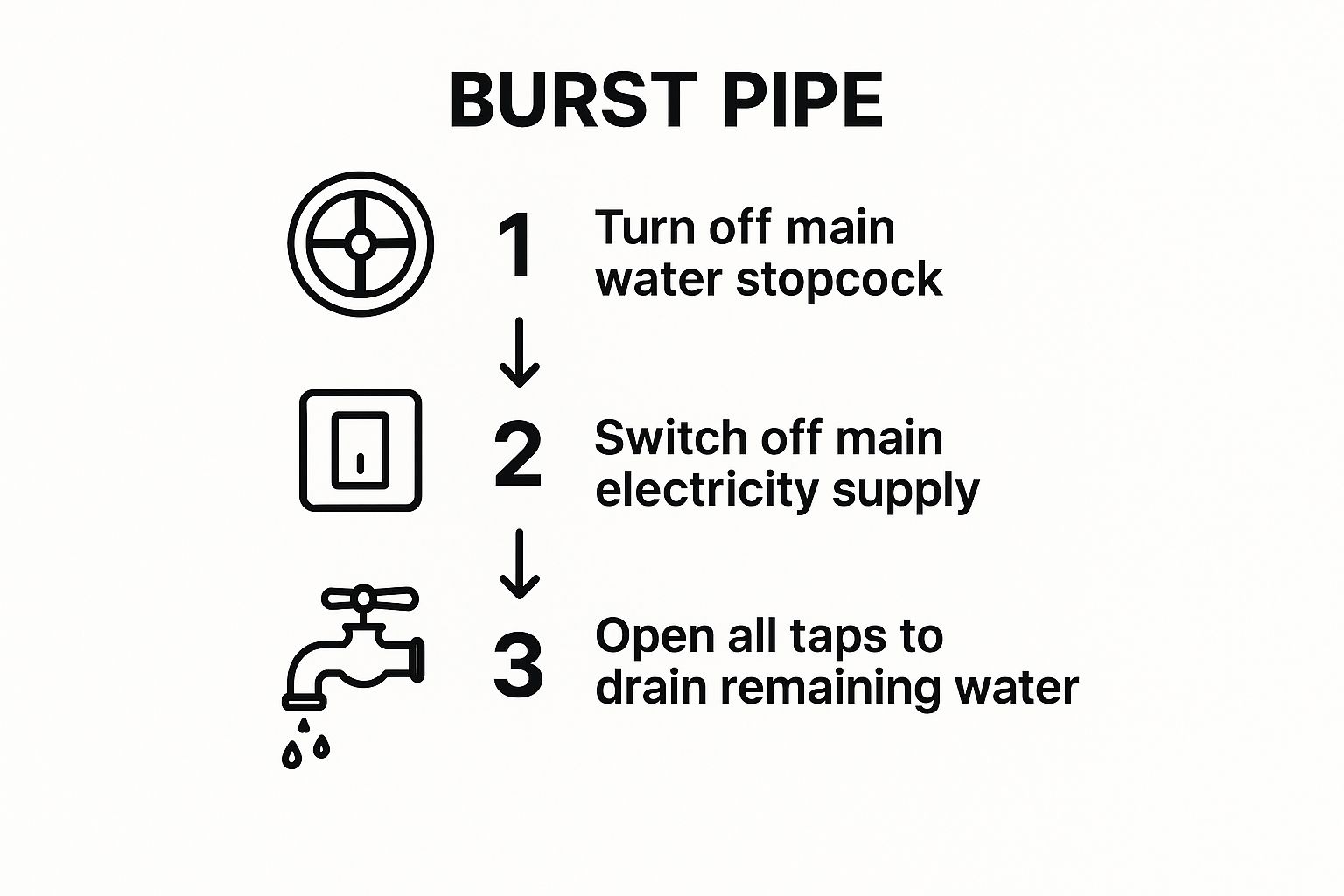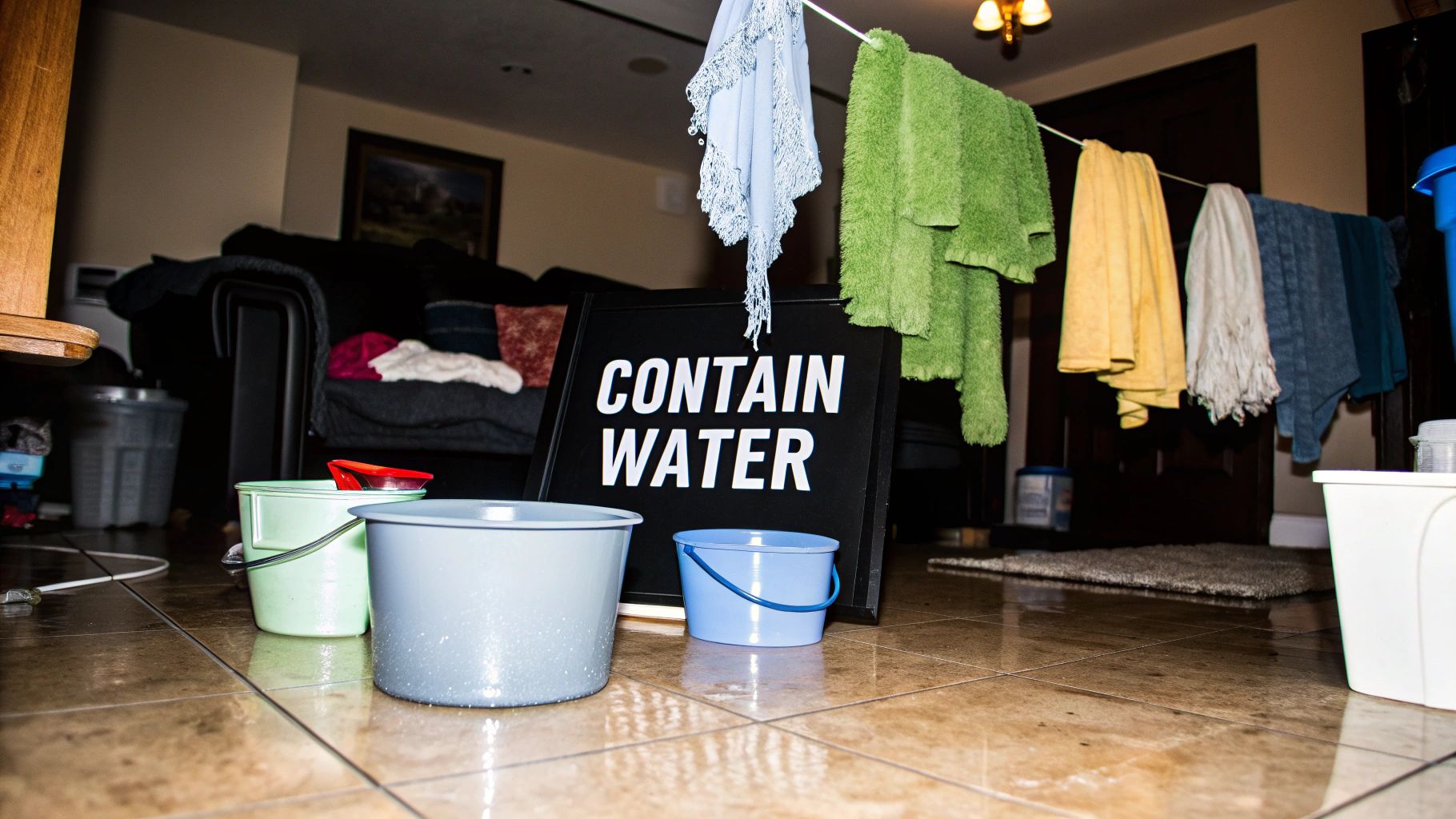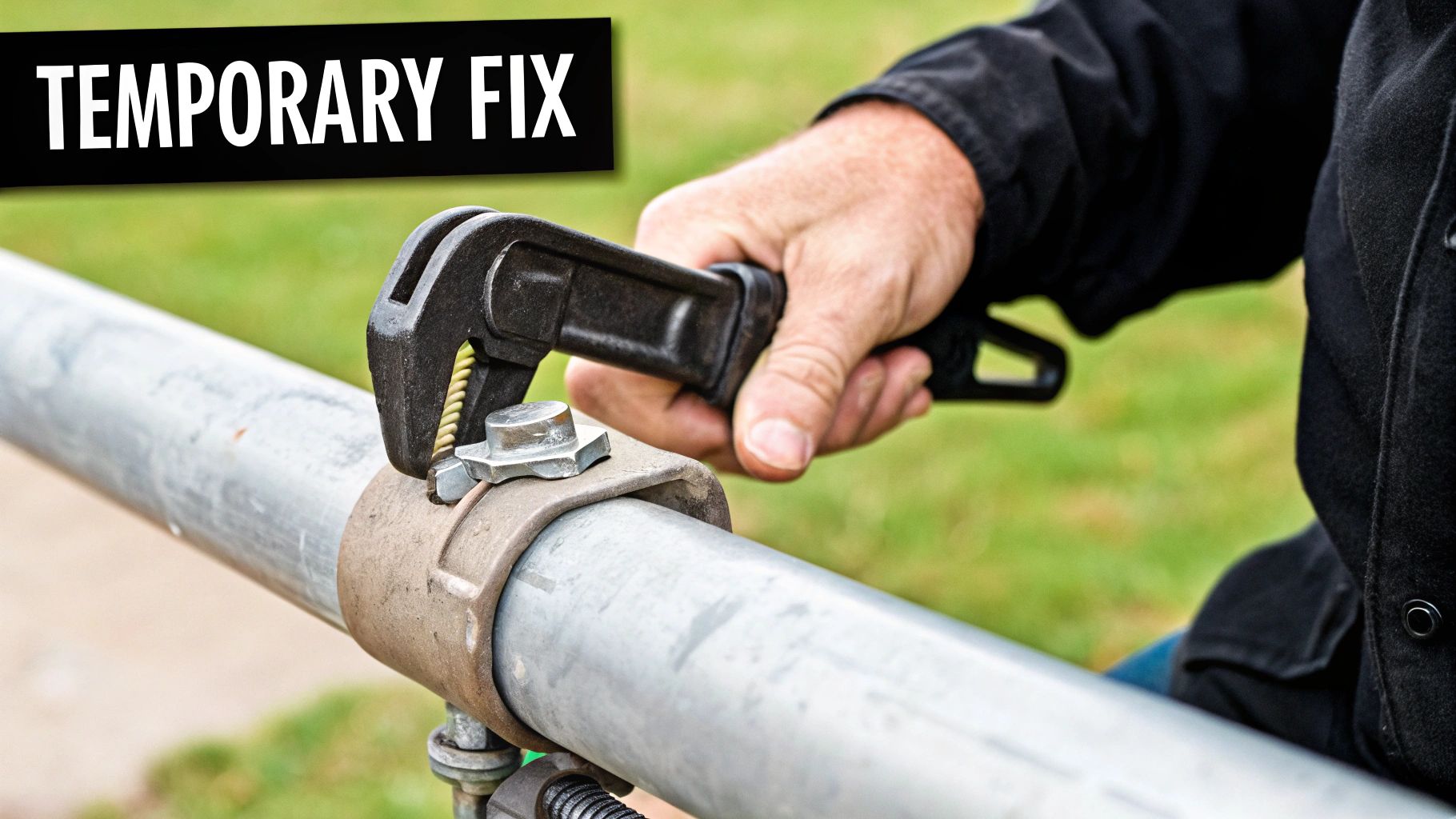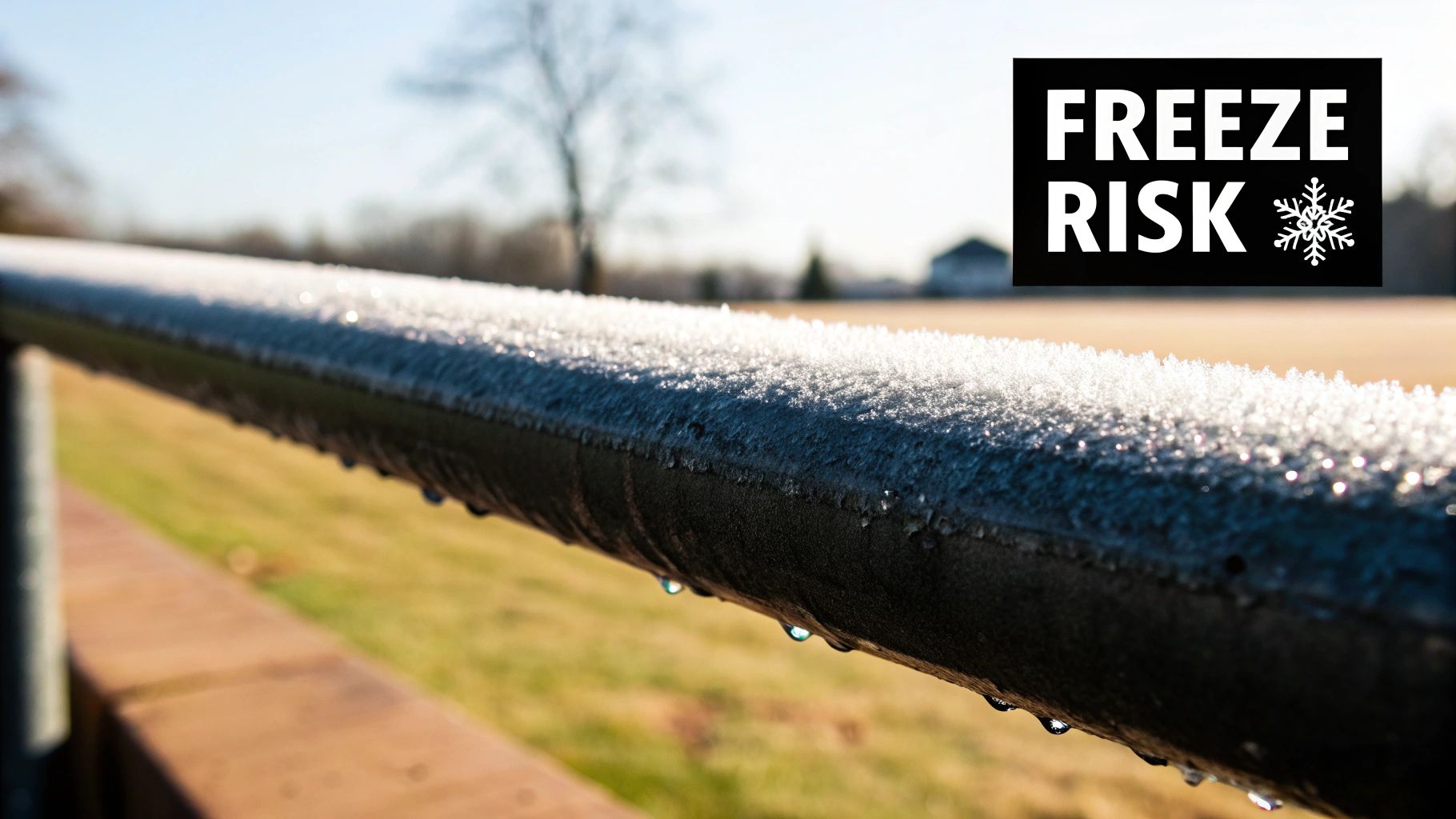What To Do If Pipe Bursts: A UK Homeowner’s Emergency Guide
- Luke Yeates
- Oct 19
- 11 min read
When you hear that unmistakable sound of rushing water where there shouldn't be any, your gut reaction is probably panic. But your first response in these crucial moments is what really counts. The key is to act quickly and decisively to get the situation under control.
Your Immediate Response Plan for a Burst Pipe
That sudden, dreaded sound of a burst pipe can send a shiver down any homeowner's spine. The trick is to stay calm and follow a clear plan to minimise the damage. Water damage from burst pipes—what insurers often call ‘escape of water’—is one of the UK's most common and expensive domestic insurance claims. In fact, insurers pay out a staggering £1.8 million every single day for it. Knowing what to do can genuinely save you thousands in repairs. You can explore the full extent of these claims and learn more from the Association of British Insurers.
To help you react correctly under pressure, here’s a quick-reference checklist. These are the immediate, non-negotiable steps to take the second you discover a leak.
Burst Pipe Emergency Checklist
Priority | Action | Why It's Critical |
|---|---|---|
1 | Shut Off the Main Water Supply | This is the source of the flood. Closing the stopcock instantly stops more water from entering your property and worsening the damage. |
2 | Turn Off the Electricity | Water and electricity are a deadly mix. Shutting off the power at the consumer unit (fuse box) prevents electric shocks and potential fires. |
3 | Drain the System | Opening all cold taps and flushing toilets releases pressure and drains water still left in the pipes, reducing the amount that leaks out. |
Following these three steps buys you precious time and puts you back in control of the situation. Let's break them down a bit more.
Locate and Shut Off the Water Main
Your first, non-negotiable action is to shut off the main water stopcock. This one valve controls all the water flowing into your home, and turning it off will stop the flood in its tracks.
Of course, finding it can be a challenge, especially in the varied properties we see around Eastbourne. In older Victorian terraced houses, it's often tucked away under the stairs or in a cellar. For newer builds, like those around the Sovereign Harbour, you'll probably find it under the kitchen sink. If you're struggling, our guide on how to turn off your water main provides detailed instructions for different types of homes.
Prioritise Electrical Safety
Water and electricity are a lethal combination. Once the water is off, your next priority is switching off your main electricity supply at the consumer unit. This is an absolutely vital step to prevent the risk of electric shock and fire, particularly if water is leaking through ceilings near light fixtures or sockets.
Crucial Takeaway: Never, ever touch electrical switches or appliances if you are standing in water or if the area is wet. Your safety comes before everything else.
Drain the System
With the water and electricity safely off, you can now relieve the pressure left in your plumbing. Go through the house and open all the cold taps fully. Don't forget to flush your toilets, too. This simple action helps drain the remaining water out of the pipes, meaning less of it will escape from the burst.
This infographic gives you a quick visual rundown of that three-step response.

Following this sequence helps you regain control while you wait for an emergency plumber, like our team here at Harrlie Plumbing and Heating, to arrive.
Containing Water and Protecting Your Property

With the water supply safely shut off, your attention has to switch immediately to damage limitation. This is the moment you physically protect your home and belongings from further harm, and believe me, what you do now can save you a fortune in repair costs down the line.
Your first job is to contain the water. Grab buckets, pots, pans—literally anything you can find that will catch drips. If water is already spreading across the floor, use old towels, blankets, or even cat litter to build temporary dams and stop it from seeping into other rooms.
We've seen how quick thinking makes all the difference in Eastbourne homes. One client near Meads Village used a large plastic storage box to catch a torrent of water pouring from a bulging ceiling, which single-handedly saved their entire downstairs from being ruined.
Salvage and Document Everything
Once you've got the active leak under control, you need to act fast to protect your possessions.
Move Valuables: Get furniture, rugs, electronics, and any sentimental items out of the affected area as quickly as you can.
Prioritise Safety: If water is pooling near electricals you couldn't switch off earlier, be extremely careful. It is always better to leave an item behind than risk an electric shock.
Document the Damage: Use your phone to take as many photos and videos as possible. Get clear shots of the source of the leak, the extent of the water damage, and any of your belongings that have been affected.
Insurance Tip: Detailed visual evidence is your best friend when you contact your insurer. It provides an indisputable record of the situation right after it happened, which can prevent any disputes about the cause or extent of the damage later.
To prevent mould from setting in and to make cleanup easier, you may need to move soggy items to a safe, dry location. This is where using emergency storage space can be a lifesaver. It clears the way for professionals, like our team at Harrlie Plumbing and Heating, to get in and fix the pipe without causing any more disruption.
Making a Safe Temporary Repair

While you're waiting for a professional to arrive, a temporary fix can be a lifesaver. This isn't about solving the problem for good; it's about damage control. You're simply buying yourself some valuable time and stopping a bad situation from getting much, much worse.
The idea is to create a stopgap seal over the burst section of the pipe. You can grab what you need from most local hardware shops in Eastbourne. The go-to options for homeowners are usually a specialist epoxy putty or a proper pipe repair clamp.
Creating Your Temporary Seal
Right, before you even think about patching anything, you need to get the area around the burst as clean and dry as you possibly can. Grab an old towel or cloth and wipe the pipe down thoroughly. Any lingering moisture or dirt will stop you from getting a decent seal.
Once it's bone dry, you're ready to apply the patch.
For Epoxy Putty: You'll need to knead the putty, following the instructions on the packet, until it’s soft and ready to use. Then, press it firmly over the crack or hole, making sure it moulds into the gap.
For a Pipe Repair Clamp: This is often the more reliable option. Wrap the rubber sleeve from the clamp directly over the burst area. After that, fit the metal housing around it and tighten the screws until it's snug and secure.
Either of these methods should be effective enough to slow or completely stop the leak, giving you some much-needed breathing room. If you're tackling a plastic pipe, you might find some useful extra tips in our guide on how to repair a leak in a PVC pipe.
Remember, a temporary fix is exactly that—temporary. It’s a stopgap measure designed purely to hold things together until a certified plumber, like our team at Harrlie Plumbing and Heating, can come and sort it out with a permanent, professional repair.
Don't be tempted to think this patch will last forever. Its only job is to hold the line until an expert can properly assess the damage and give you a safe, lasting solution.
How to Call an Emergency Plumber
When your home is flooding, the last thing you want is to be fumbling for the right words or number. The stress of the situation can make it hard to think straight, but knowing exactly who to call and what to say can make all the difference in getting a fast, effective response.
When you ring a professional, be ready to give them the essential details right away. This allows them to gauge how urgent things are and show up prepared. For instance, if you called our team at Harrlie Plumbing and Heating, we'd immediately need your precise location in Eastbourne, a clear description of where the water is coming from, and a quick summary of what you've already done (like turning off the stopcock). This helps us dispatch the right engineer with the correct tools, saving precious time.
Choosing the Right Plumber Quickly
In a proper emergency, you don’t have time to trawl through pages of websites, but you still need to make a smart choice. A few key indicators can help you vet a plumber swiftly and avoid unqualified cowboys who might just make things worse.
Here’s what to look for on the double:
24/7 Availability: A genuine emergency service operates around the clock. Make sure they offer a true 24/7 call-out, not just an answering machine that someone might check in the morning.
Gas Safe Registration: If the burst pipe is connected to your boiler or central heating, the engineer must be Gas Safe registered. This isn't just good practice; it's a legal requirement for any gas-related work in the UK.
Positive Local Reviews: A quick search for reviews from other Eastbourne residents can give you an immediate feel for a company's reliability and the quality of their work.
Key Takeaway: Making a swift, informed decision now doesn't just fix the immediate crisis. It also helps prevent long-term headaches like hidden mould growth or structural rot that can fester after a botched repair.
Calling a trusted local firm like Harrlie Plumbing and Heating ensures you get qualified, experienced professionals who know how to handle the situation correctly from the moment they arrive.
Understanding Why Pipes Burst in the First Place

To prevent another plumbing disaster down the line, it helps to know what causes a pipe to fail. Once you understand the common culprits, you can take practical steps to protect your property from the chaos and expense of water damage.
The number one cause, especially here in the UK, is the cold. When water freezes, it expands by roughly 9%, putting an incredible amount of pressure on the inside of a pipe—far more than it was ever built to withstand. Eventually, something has to give, and the pipe splits or ruptures.
This isn't just a freak accident; it's a huge national problem. Burst pipes are a common disaster for homeowners, with data showing that around 2,650 domestic pipes burst every year in the UK. The resulting damage adds up to nearly £50 million annually. You can read the full breakdown of these insurance claims to see just how widespread this issue is.
Beyond the Winter Chill
While icy weather is the main offender, it’s not the only risk you need to worry about. Many homes in Eastbourne, particularly our beautiful period properties, have older pipework that’s naturally more vulnerable to failure.
Here are a few other common causes we see all the time:
Ageing Pipework: Older pipes, especially those made from galvanised iron, can corrode from the inside out over the decades. This gradual decay weakens the pipe walls, making a burst almost inevitable at some point.
High Water Pressure: If your home's water pressure is cranked up too high, it puts constant strain on your entire plumbing system. That stress can eventually cause a catastrophic failure at the weakest point in the network.
Accidental Damage: It’s surprisingly easy to hit a water pipe during a bit of DIY. Drilling into a wall or lifting floorboards without knowing what’s underneath can turn a simple job into a major flood in seconds.
Our Proactive Tip: Knowing these risks is the first step towards prevention. A periodic plumbing inspection, particularly for older properties, is a smart investment. Our team at Harrlie Plumbing and Heating can assess your system's health, pinpoint potential weak spots, and suggest solutions before they turn into a crisis.
Right, the immediate chaos of a burst pipe is over, and you've managed to get the water off. What now? The next phase is all about recovery, and that means two things: sorting out the insurance claim and getting the water damage professionally cleaned up.
First things first, get on the phone with your insurance provider as soon as you can. Those photos and videos you took in the heat of the moment? They’re your best evidence now. It’s also incredibly helpful to have a detailed report from a certified plumber—like one of our team at Harrlie Plumbing and Heating. A professional report officially documents what happened and how bad the damage is, which really strengthens your claim. If you're wondering what this all might cost, our guide on UK burst pipe repair costs is a good read, as those figures often line up with insurance payouts.
Why Professional Cleanup is Non-Negotiable
You might have mopped up all the visible water, and that's a great start, but the real trouble is the moisture you can't see. Water has a nasty habit of seeping into walls, creeping under floorboards, and soaking into insulation. Left unchecked, it's a perfect breeding ground for mould, mildew, and can even cause structural rot over time.
Professional restoration specialists don't just guess. They come in with industrial-grade dehumidifiers and moisture meters to make absolutely certain your property is bone dry. This is about protecting your home's long-term health and value.
Dealing with insurance companies isn't always straightforward. If you find yourself hitting a wall or getting the runaround, knowing how to put together a solid formal complaint letter template can be a powerful tool to get things moving.
Got Questions About Burst Pipes? We've Got Answers
Over the years, we've handled countless burst pipe emergencies across Eastbourne. It’s a stressful situation, and it’s natural to have a lot of questions running through your mind. Here are some of the most common queries we hear, along with some straight-talking answers to help you out.
How Can I Tell If a Pipe Is Frozen?
A frozen pipe is a burst pipe waiting to happen, so catching it early is key. Keep an eye out for a few tell-tale signs. You might literally see frost forming on the outside of the pipe, especially in colder areas like the loft or garage.
Other clues are more subtle. You might hear strange gurgling or banging noises when you turn on a tap, or maybe you'll notice the water pressure has suddenly dropped to a weak trickle. If you spot any of these, it’s time to act fast before the pipe thaws and splits.
Will My Home Insurance Cover This?
This is a big worry for many homeowners, and rightly so. The good news is that most standard UK home insurance policies provide cover for what they call ‘escape of water’. This typically pays for the damage caused to your home and belongings—like ruined carpets, damaged ceilings, and warped furniture.
However, a crucial detail to remember is that the policy often won't cover the cost of the actual plumbing repair itself. It’s always best to pull out your policy documents and double-check the specifics to avoid any nasty surprises.
How Long Does a Repair Take?
The honest answer? It depends. If it’s a straightforward job where the burst pipe is easy to get to—say, under a kitchen sink—one of our plumbers at Harrlie Plumbing and Heating can usually have it sorted in just 1-3 hours.
But, as is often the case in older Eastbourne properties, pipes can be hidden behind walls or tucked away under floorboards. In those situations, the repair will naturally take longer. We have to carefully access the pipe to fix it without causing unnecessary damage to your home, which requires a bit more time and care.
Key Prevention Tip: An ounce of prevention is truly worth a pound of cure here. You can dramatically reduce your risk by lagging any pipes in cold spots like lofts and garages. Also, keep your heating on a low, constant setting during freezing weather and make sure to fix any dripping taps, as they’re often the first to freeze.
If you're dealing with a burst pipe emergency in the Eastbourne area, don't let the problem escalate. Contact Harrlie Plumbing and Heating right away for a fast, professional response to get things back to normal. https://www.harrlieplumbing.co.uk

Comments